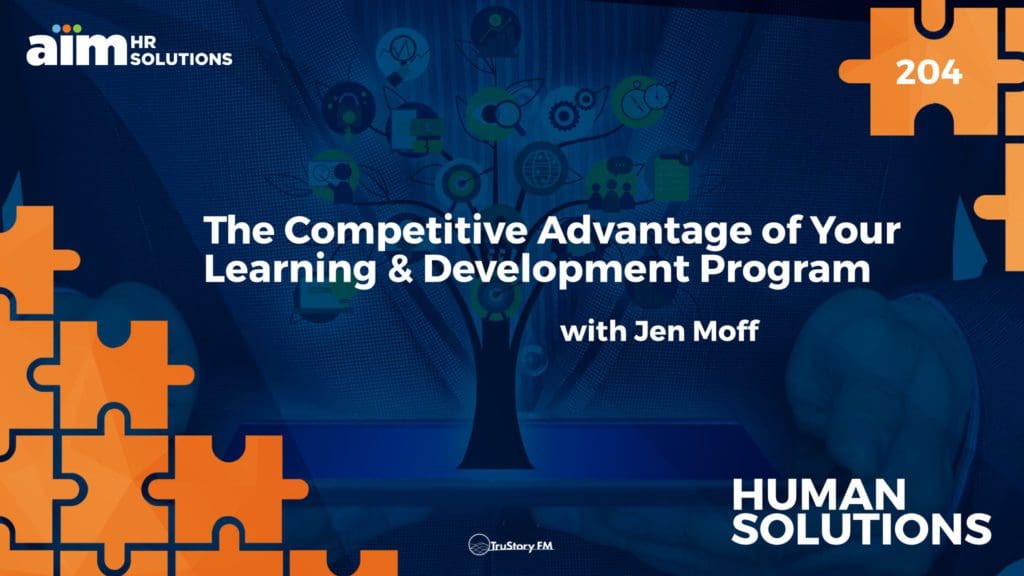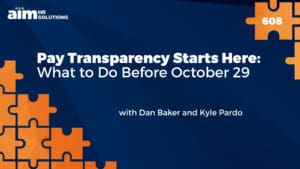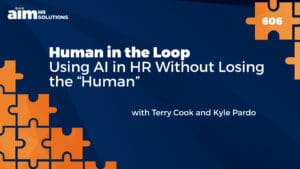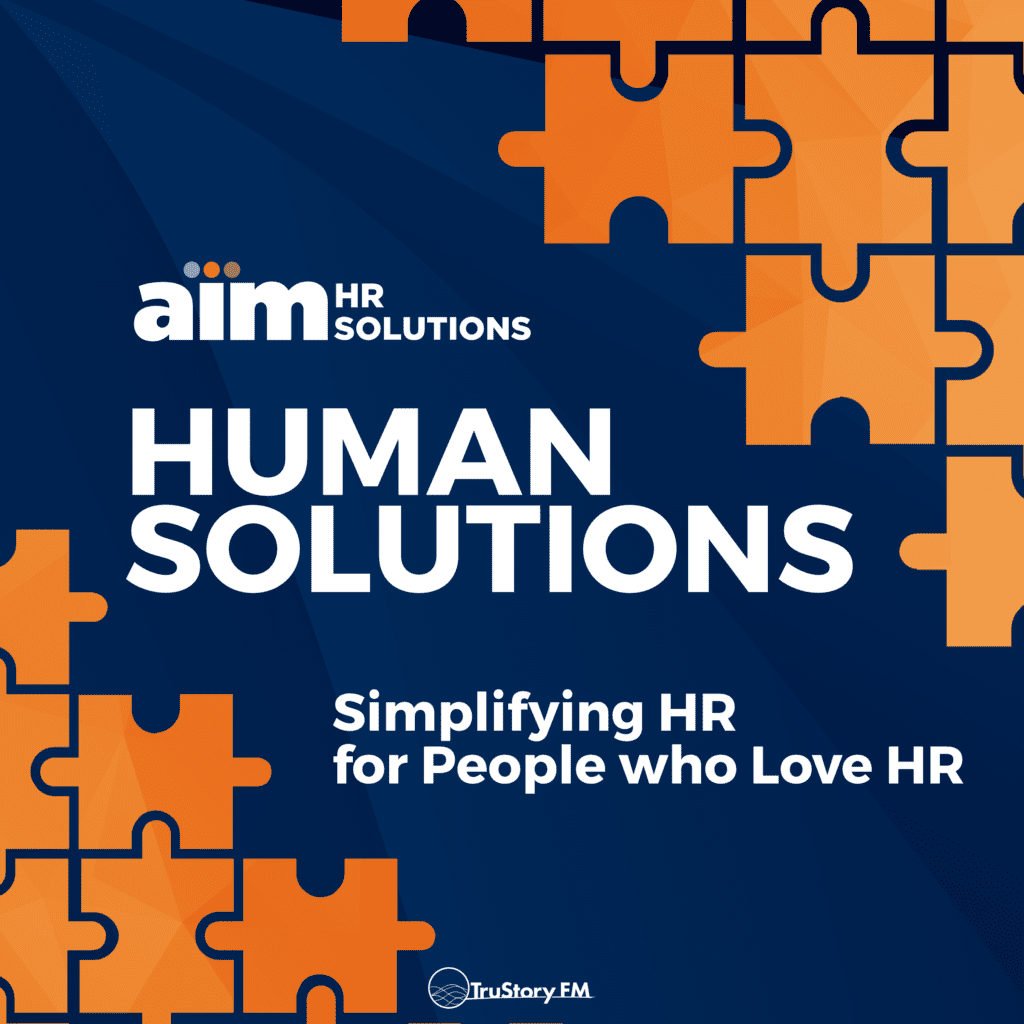The economy is unpredictable, which can trickle down to your workplace budgets. One of the first line items to face scrutiny is the learning and development program. The truth is that a robust L&D program could be a competitive advantage for your organization. It could be the key to helping you retain and attract talent. Jen Moff joins Pete Wright to explore the topic of L&D programs and the ROI and benefits they can provide your organization.
Learning and development can transform how your employees feel about their role and company. When we think of the benefits of training or education and development, it is often not just a dollar amount. Instead, it is seen in the organization’s culture, recruitment and retention efforts, and many other hard-to-measure facets. What we do know is that more dynamic and strong-performing companies often have a positive learning culture. Jen Moff, our VP of Learning & Development, joins me to remind us what we’re missing if we don’t focus on our L&D.
Episode Transcript
Pete Wright:
Welcome to Human Solutions: Simplifying HR for People who Love HR, from AIM HR Solutions on TruStory FM. I’m Pete Wright, and it’s L&D week. Learning and development can transform how your employees feel about their role in the company. When we think of the benefits of training or education and development, it’s often not just a dollar amount. Instead, it’s the organization’s culture, recruitment and retention efforts, and many other hard to measure aspects of the organization. What we know is that more dynamic and strong performing companies often have a positive learning culture. This week, Jen Moff, our very own VP of learning and development joined me to remind us what we’re missing if we’re not focusing on L&D. Jen Moff, welcome back to Human Solutions.
Jen Moff:
Pete, thank you for having me. It’s always a pleasure.
Pete Wright:
Jen, would you give us an overview of an L&D program? What is the high level overview of what a good L&D program looks like in an organization? How do I know it’s working?
Jen Moff:
Let’s start with what L&D is. Basically it’s a function that is sometimes found within human resources or people in culture departments that is focused on empowering employees with knowledge or skills to drive business performance, essentially. That’s what it is. So how do we do that? We do that by a couple of things. First part is research and that comes in the form of identifying where gaps are in terms of that knowledge and skill. So we can partner with companies to come in and do a training needs analysis and when that happens, we learn what’s actually going on and what we think might be going on underneath it all. And we create some solutions for them, solutions can look like different things.
Jen Moff:
One way we can provide a solution is through coaching, because that’s part of development. Another way is through some consultative services. We can also do trainings, like we’re typically thinking of anyway with training departments. We can also create job aids. Here’s a great example of a job aid. So you know when you are driving somewhere and, especially here in Boston for those listeners here in Massachusetts, downtown, it can be really challenging to know when you can park someplace in certain boroughs, so there’s signage that tells you this is available at this day and this time, here is the code that you need to enter in this website. That sign is a job aid. Job aids are tools that are used in strategic situations where you are not expected to remember the information, but it shows you how to operate in that environment. So that’s actually something that we do.
Pete Wright:
Okay. Building signs.
Jen Moff:
Well, we wouldn’t actually manufacture them. There are far and way better people that do that.
Pete Wright:
You don’t have just giant rolls of paper and markers and I feel like it’s that and the “Under the Sea Dance” is coming where-
Jen Moff:
I have a vinyl manufacturer back in this little room over here.
Pete Wright:
Okay. So that’s what L&D is, right? Those are some of the core components. Let’s talk about how you implement it at an organization. What is an organization? How do you know… If I’m in my mythical manufacturing organization, created bespoke for this show, how do I know when I need one?
Jen Moff:
So there’s a couple of things. Some companies have learning and development departments in-house and some don’t, and that usually depends on size of the organization. But when you get to a point where you realize there’s things that we need our people to be doing, or things that maybe we take for granted that we know that we realize other people don’t know. That’s when we realize maybe we need to bring in a company to help us with our learning and development if we don’t have that internally already. Or, if you do have that internally, that’s when you might go to that department as a manager and say, “Hey, knock, knock, knock. I need some help with this. Do we have any materials or training or what can we do here?”
Jen Moff:
In a very kind of basic sense… say, I need to learn how to use Excel for my job and I think I know a little bit, but there’s things like pivot tables and code that I don’t know how to use in there. So learning and development might have somebody there that I could shadow that I could observe that could mentor me, that could coach me through how to learn it. They might have some E-learning classes that I could sign up for and take online to practice how to create different things in Excel that I needed to learn. There might be an upcoming class that another company that offers Excel training, that they could recommend you to to learn how to do these things live with an instructor. So that’s one way and that’s a very tangible, hard-skilled kind of training, so to speak.
Pete Wright:
It strikes me that… You talk about dependence on the size of the organization, it strikes me that there might be this transformation or this transformational leap where you get to the point where you realize, “Wow, we have a manager or two that seems to know everything.” They also have a job, but we’re asking them to do a lot of informal training for new people and that’s becoming a stress on them. They can’t do both those things, training new people for all of the [inaudible 00:06:15] processes that they have developed over the years and know inside and out, and also do their job of managing their team and delivering on their product. And so making that leap from sort of disenfranchised training across managers who’ve been here for a long time, to centralized, intentional learning and development, it seems like that’s a big but important leap to make.
Jen Moff:
Yeah. It starts with mindset. You have to see the value. You have to believe in the value of lightening that person’s load and seeing how we can basically scale our internal development when we take it off of all of these individuals and create a hub, so to speak, where learning happens rather than just placing the responsibility on individuals out in the wild, so to speak.
Pete Wright:
What do you look for when you help an organization make that transformational leap when… Who is it that gets into these roles of leading the new consolidated effort? If you’re a manager who’s in charge of building an L&D department, who are you going to put in that role?
Jen Moff:
So there’s some specific roles that you want on an L&D team. You want someone… to start with, you need an instructional designer. Instructional designers are individuals who are experts at identifying and building transformational learning experiences. And those can be built in all of those ways that I mentioned before. People often think that a training is just like a lecture you go to, but in a pyramid-
Pete Wright:
Or just a web training. So you never see an instructor, it’s just click here and you’ve gone through FERPA training, sign the box.
Jen Moff:
Yeah. There’s tons of assumptions about what falls under the umbrella and when all somebody’s been exposed to is just kind of on the job training, they might not know what’s next or how to start. So they bring in somebody, maybe like myself, who knows more than they do. They don’t know what they don’t know. So they realize, “We’ve got to bring in somebody else.” Those are the best companies, that realize, “We’ve got to make some changes.” They have that awareness and that desire and that humility to bring in outside help. From there, it’s really about that research piece that I mentioned at the beginning. It always has to start with research. Where are you at? Where do you want to go? What’s missing? What resources do you have? What things do you need that you don’t have? And what does the road ahead look like? How long is the road going to be to get you from point A to point B and how many milestones are in the process?
Pete Wright:
I think it’s… the reason I want to start that part of the conversation with your insights on a new organization trying to develop learning and development, because I feel like you’re still at this very aspirational stage. We don’t know what we don’t know, but we do know that there are lots of benefits on our existing staff if we start to consolidate these efforts and really formalize training. So we all end up knowing the same things and do our jobs better, but we’re also on the heels of a considerable cycle, down cycle, for many companies who have been struggling and L&D feels like it’s constantly on the block of decreasing investment over time. And that takes us to this next part of the conversation, which is what is the impact on an organization when you’ve had L&D and then you take it away? What do you lose? What are you forgetting by making those choices?
Jen Moff:
Pete, Pete, Pete. I cannot talk about this enough. So basically you could superimpose any other department on that same situation. If you take away any department that has been relied on to do what it does and does well, and they aren’t noticed because they’re doing a good job, when you take them away, all of a sudden, things will start breaking. So, for example, part of what L&D does is to think about operational processes, too. That’s something that we also notice. Do you have the right technology in place? Do you have the right workflows here? Those things all need built. A lot of times for a company, say you’re at like 50 employees or so, you might not have your own internal department and you’d bring in some outside firm or consultancy to help. And that works for a while and that supports the goals and the initiatives.
Jen Moff:
And then you’re like, “You know what? I think we’re doing okay. We don’t need you anymore.” So you go back to doing your own thing, just 50 of you, no outside help. And without having a guide post, without having someone in the driver’s seat, it’s like getting in your car in a city where you don’t know you should be going and saying, “I need to get to the nearest gas station,” but you don’t have a map and you don’t have GPS, you’re just going to be driving around aimlessly and hoping that eventually you’ll get there. And you might. You absolutely might. There’s plenty of gas stations around, but have you gotten their efficiently? Have you saved yourself time? Have you saved yourself gas money? That’s where having a designated department who can lead and optimize and prioritize things creates value.
Pete Wright:
Not to put too fine a point on it, but when you are going through all of the ropes of driving around town looking for a gas station when you don’t know where a gas station is and don’t have the tools to find a gas station, that leads to organizational burnout, right? I mean, that leads to the kind of frustration we talked about just last week in saving your people the frustration, or causing them the frustration by not giving them the tools to do the job.
Jen Moff:
You make a great point. And it kind of goes back to even… There’s a gentleman by the name of Jean Piaget, and he’s an expert in early childhood development, and I took some courses on that in school, and part of the tie-in there is children need structure. They need guidance. They need something to look to for leadership, to feel safe in the world. And at our heart, we’re all just big kids. I mean, we’ve grown up, we have more adult bodies, we have more mature mindsets and mental and emotional health, but that need is still there, having some kind of beacon to guide. So without that, that impacts feelings of safety in the workplace, it’s very nuanced and very subtle, but it’s absolutely there.
Pete Wright:
Another thing that you said that I’m really connecting with, and it reminds me of I did a presentation once for a local SHRM organization, and I was presenting with a former Special Forces service member, a frogman, and he had this way of talking about what learning and development did for larger organizations in particular that has stuck with me now for 20 years. And he didn’t attribute it, it’s not his quote, he said, “This is just of the axiomatic awareness of what we do in special forces is like preparedness is not being able to see what’s out on the horizon or even what’s out beyond the horizon. Preparedness is being able to look out and see what’s beyond every horizon.”
Pete Wright:
And to me, that connects directly back to our learning and development needs. When you talk about working with individual departments, divisions, functions, and helping them focus on what’s out on the horizon, to be the eyes to say, “Hey, I can help you. If you can’t do your job, let’s find the tools, technology, resources, get them in place and help you learn to use them better and be functionally efficient.” That’s a really powerful message that risks being lost in times of downturn.
Jen Moff:
Yeah, absolutely. People think, “Oh, training is just this thing that we check a box on,” that it’s gotten this reputation somewhere along the way that, “Oh, we need to get some training, we’ll do this one off and that’s it.” But that’s not it. It’s not a box that you check. This is… There’s a huge difference between companies who are embracing learning and growth as a core value and those who do not.
Pete Wright:
My kids go to a… or when they were younger. They’re so old. They went to a local outdoor skills survival camp.
Jen Moff:
Oh, cool.
Pete Wright:
It was very, very cool. And the motto of the camp for many, many years was something that turns people’s heads, I think negatively at first, I’m just going to tell you what it is and see what your face does.
Jen Moff:
Okay. Okay.
Pete Wright:
“You’re doing it wrong. Do it better.” The intention behind it is when you are carving something with a large knife, when you are doing something, and you’re doing it in a way that is dangerous or inefficient to others around you, or you’re never going to start a fire if you do it that way, let’s find a way to work together to do it better. Let’s find a way. You are objectively doing it wrong, so let’s find a way to do it better. What I love about that saying, and I know that seems very strange, we don’t talk to each other that way, but what I love about it so much is when you talk to each other that way enough, it becomes a part of the culture and you start to think, “If there is a way for me to do it better, I would like you to tell me that I can do it better.” And that is what learning and development is. Is an organization saying, “I can help you do it better. Let’s do that.”
Jen Moff:
And that requires willingness and humility and curiosity, those muscles that we talk about time and time again, to grow and build. I love evolving, but I also recognize that that’s what put me in this work that I do and not everybody feels that way. Not everybody embraces change in the same way that I do. So part of a good instructional designer’s job is to get in the heads of all of the people that are going to be impacted, affected so on and so forth, and imagine what their day to day reality is, how to make things easier, how to make things more fun for them to transition from where they are now to that next point. I’ll be honest, I’m going to throw my dad under the bus. Sorry, dad, if you ever listen to this. He, years ago, used to talk about how he would go to these conferences and they would have to go to some training just as a one-off.
Jen Moff:
And he’s like, “I don’t like these things at all. They come in and they don’t know what it’s like for us. They just want us to stand up there and do a little trust fall. I don’t like it.” And I said, “I get it, because you don’t feel like they really understand what you’re going through.” And even if they tried to make that effort to understand and how they created that, it clearly missed the mark. And that’s how we can tell if there is good training or if there’s not good training happening or learning and development initiatives in any way, shape or form. You have to, after the thing has been implemented, talk to the people again, talk to your people, do that research piece again. It’s not just at the beginning, it’s throughout, continue having conversations. Checks and balances are so important in our work. We want you to be successful. We want you to make more money, save time, have more fun, reduce stress. That’s my own personal model that I’ve said to my team. I was like, “Anything we do is going to fall into those buckets.”
Pete Wright:
We want you to make great stuff and change the world.
Jen Moff:
Obviously. Hashtag obviously.
Pete Wright:
Hashtag obviously. Well, in so far as I think this conversation, I think this is a good reflection on the ideal of a savvy learning and development organization. It is also not a magic pill.
Jen Moff:
Absolutely not. It’s something that I feel very passionate about. Aside from learning and development, the way that I’m just kind of wired and it lends itself to me being good at the job that I do. But I also believe in lifelong learning and growth. I’ve had my own coaches over the last decade since I started this journey. I invest in therapy. I’m always asking people to be very frank with me. If there is something that I’m doing that doesn’t make sense or is hurtful or is unclear or I’m sabotaging myself, I want to be the best version of myself that I can be and I don’t in any way think that this is a precursor to “let’s have everybody be perfect” because I also don’t believe in perfection.
Jen Moff:
There’s excellence, which is different. There’s always room for improvement, permanent beta in the tech space, I sometimes use that moniker for myself, always in permanent beta, opportunities to grow and change and learn more things. And that’s certainly a value that I have. So if you don’t have that value, what values do you have and how can you maximize those to help yourself evolve and help your company evolve and grow?
Pete Wright:
If people want to learn more about the work that you do with AIM, where would you send them? Is there a direct page or just send them over to the website?
Jen Moff:
I’d just send them over to our website AIMHRsolutions.com. That’s a great place to start.
Pete Wright:
Jen Moff, our VP of learning and development, thank you so much for hanging out and talking about this wonderful topic with me. I love this stuff. I can do it all day.
Jen Moff:
Thank you so much, Pete, I always enjoy talking to you.
Pete Wright:
And thank you everybody for downloading and listening to this show. We appreciate your time and attention. Don’t forget, head over, look at the show notes, aimHRsolutions.com. You can listen to the show right there on the website or you can subscribe to the show in Apple Podcast, Spotify, anywhere else fine podcasts are served. And the best thing you can do to support this show if you appreciate what Jen and I have been talking about today is to share the show with a friend or colleague. Thanks everybody. We’ll catch you right back here next week on Human Solutions: Simplifying HR for People who Love HR.











